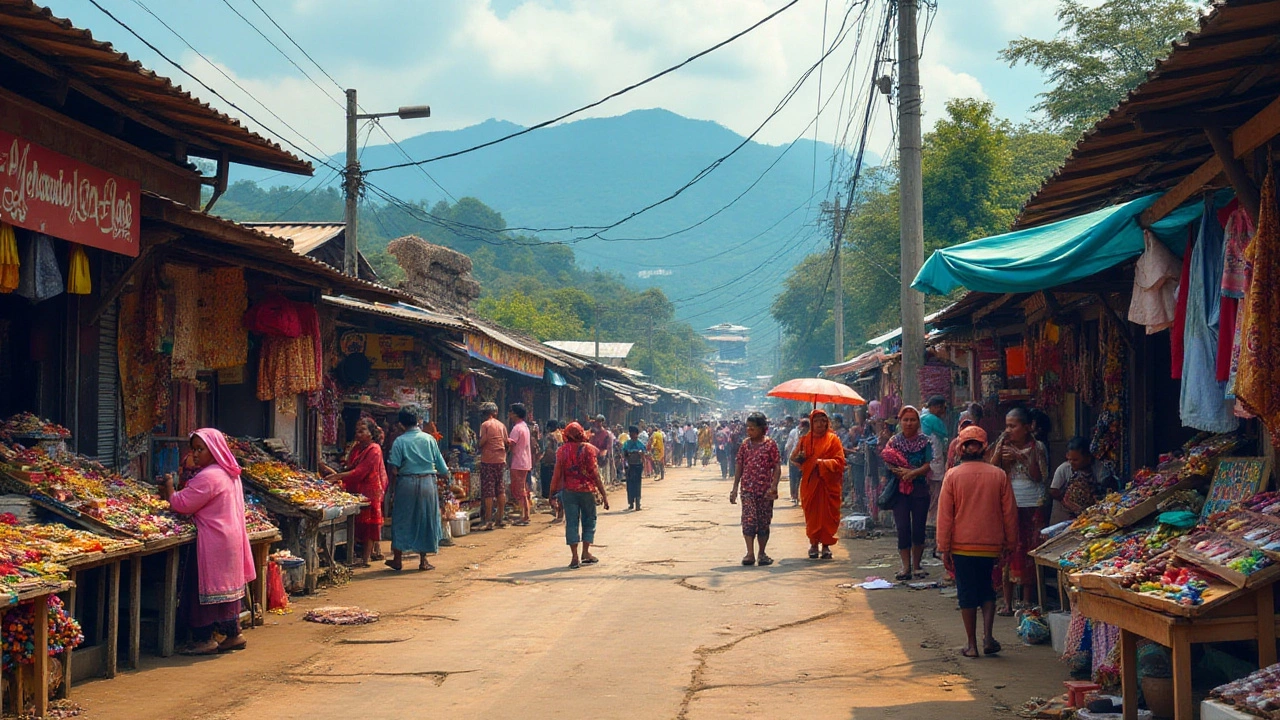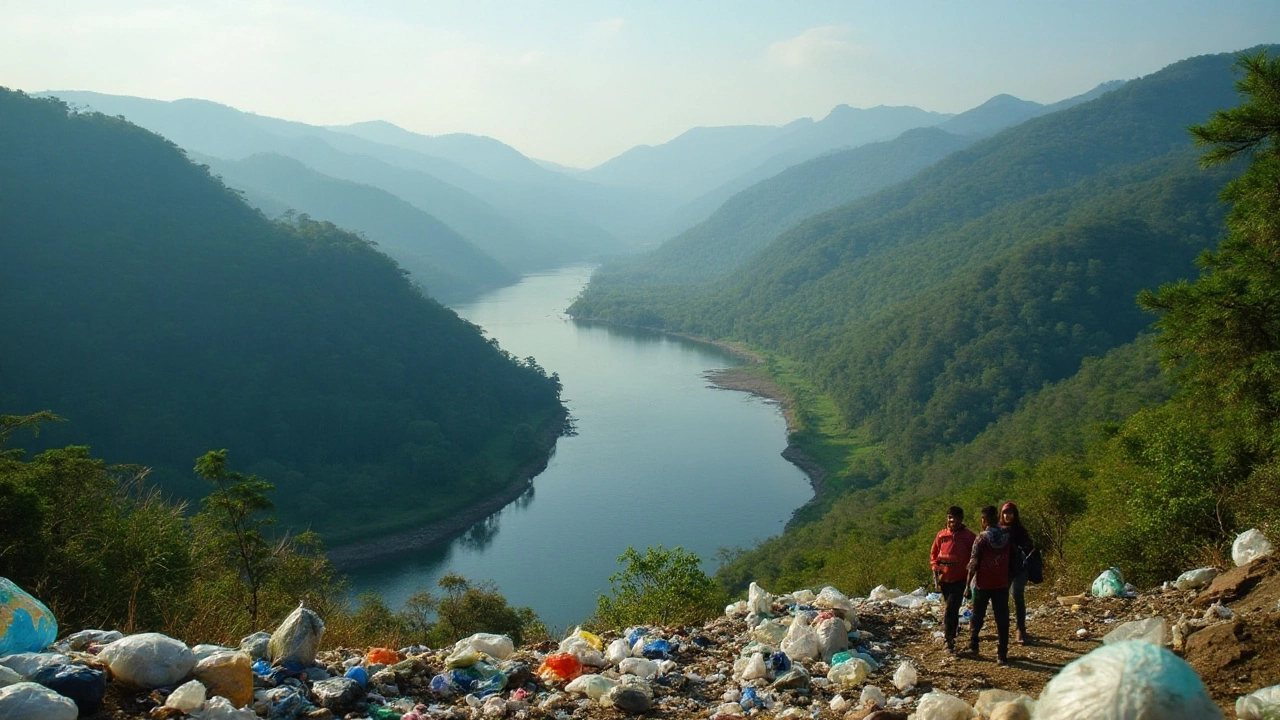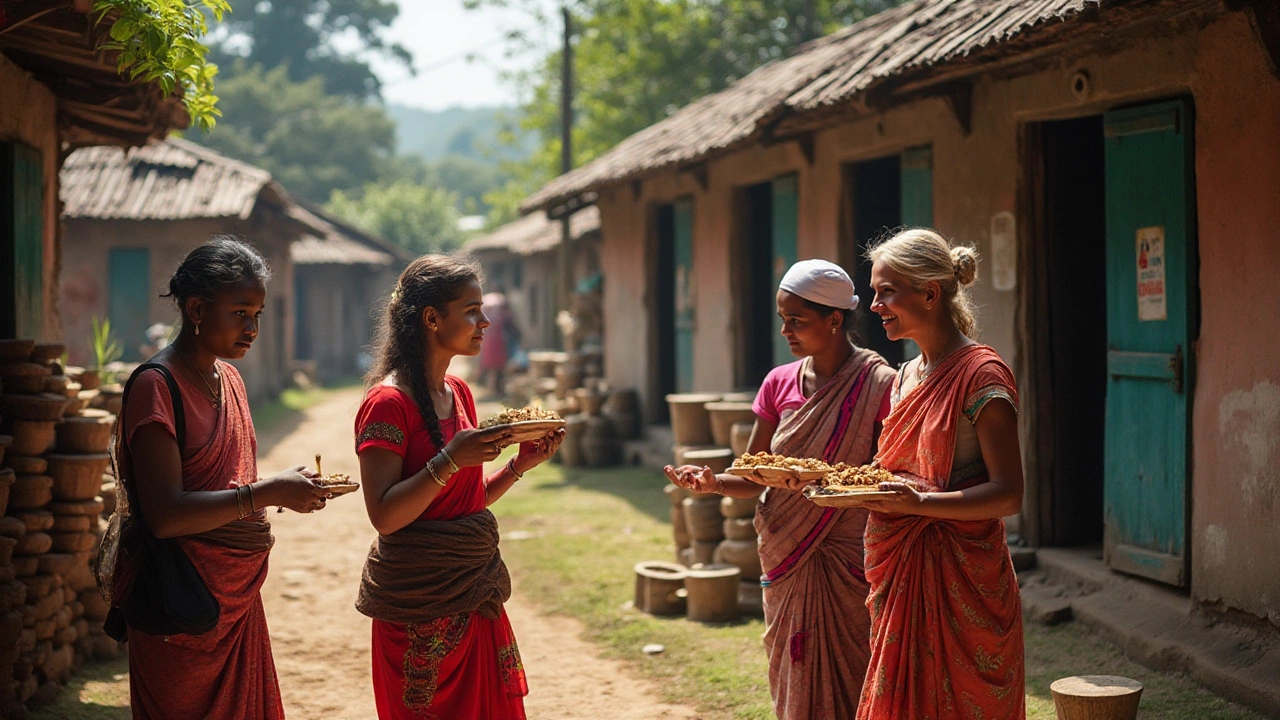Challenges Facing Tourism in Northeast India
 Jan, 26 2025
Jan, 26 2025
Northeast India is a treasure trove of natural beauty, rich cultures, and remarkable history. Yet, despite its charms, the region's tourism scene is fraught with obstacles. Travelers often find themselves navigating not just its scenic landscapes, but also a range of hindrances that can detract from their experience.
The difficulty of access and a lack of adequate infrastructure are among the most pressing challenges. With much of the region nestled in remote valleys and steep hills, getting around can be a significant hurdle. For those who do make the trip, the struggle to find decent accommodation and reliable transport is a common story.
Environmental concerns loom large as well. This part of India is home to diverse ecosystems that are sensitive to large volumes of tourists. Understanding the balance between promoting tourism and preserving the environment is something both visitors and policymakers need to prioritize.
- Accessibility and Infrastructure Challenges
- Environmental Impacts and Sustainability Concerns
- Cultural Sensitivity and Preservation
- Political Instability and Safety
- Local Community Engagement
Accessibility and Infrastructure Challenges
Traveling to Northeast India can sometimes feel like journeying to the edge of the world. Despite its burgeoning appeal, the region struggles with accessibility issues. The picturesque states of Assam, Meghalaya, Arunachal Pradesh, Nagaland, Manipur, Mizoram, Tripura, and Sikkim are connected by winding roads that are often narrow and can be treacherous, especially during the monsoon season. The limited availability of direct flights to regional airports like Guwahati, Shillong, and Imphal also complicates travel planning for many potential visitors. Air connectivity improvements could unleash the potential for increased tourist traffic, but such enhancements are still works in progress.
Once travelers manage to reach these breathtaking areas, they often confront the next hurdle: inadequate infrastructure. Many parts of the region lack the necessary facilities to accommodate large numbers of visitors. The scarcity of quality accommodations can deter tourists seeking comfort. Smaller hotels and guesthouses may not meet international standards, which might not appeal to everyone. The lack of proper road networks further impedes access to the interiors, affecting not only tourist experiences but also local livelihoods. Improving these structures could bring about a much-needed boost to the local economy, but requires coordinated efforts and investment.
A significant problem is also the availability of consistent utilities. Electricity shortages and water supply interruptions are common in remote areas. The government is aware of these issues and plans to develop infrastructure with modern amenities, but such initiatives can be time-consuming. About 30% of the rural population in Northeast India remains without electricity as per recent figures, creating a substantial barrier for tourists accustomed to reliable power sources.
According to a recent report by the Ministry of Tourism, “Robust infrastructure development is the backbone of the tourism industry. Improving facilities not only improves tourist satisfaction but also drives economic growth in rural and remote areas.”Improving infrastructure is crucial, but so is preserving the region's pristine environment. Careless development could lead to ecological damage. Decision-makers face the challenge of balancing infrastructural advancements with sustainable practices to protect the unique landscapes and cultures that define the region.
Local governments and communities have a vital role in addressing these challenges. Engaging local stakeholders ensures that development projects meet the needs of both residents and tourists. Training local people to handle tourism better is essential, as it creates job opportunities while ensuring a welcoming experience for visitors. Ultimately, building infrastructure in harmony with nature—and involving local voices in that process—can turn these existing challenges into opportunities for sustainable growth.
Environmental Impacts and Sustainability Concerns
In the breathtaking landscapes of Northeast India lies a delicate balance between nature and tourism that is constantly threatened by the very visitors who come to admire it. The region, home to dense forests, pristine rivers, and diverse wildlife, has always been a haven for those seeking refuge from the urban chaos. However, the influx of travelers brings a set of environmental challenges that require urgent attention. From the litter that clogs scenic pathways to the noise pollution disrupting the peace of wildlife, the effects are transformative in the most concerning ways.
Heavy tourist footfall often leads to soil erosion and habitat disruption, particularly in fragile ecosystems like those found in parts of Assam and Arunachal Pradesh. The overuse of natural resources also poses a threat. Local water supplies can become strained, while increased demand for amenities such as electricity puts pressure on infrastructure meant to conserve these vital resources. The region's biodiversity, which includes rare species such as the one-horned rhinoceros, faces risks as their habitats shrink or become fragmented.
Waste Management Issues
As the number of tourists rises, so does the amount of waste they generate. Managing waste effectively is a significant issue in many areas where formal collection systems are lacking. The plastic waste from packaged goods and water bottles is of particular concern. With limited waste processing facilities, much of this refuse finds its way into the environment, polluting rivers and landscapes. This is a stark contrast to the minimal waste produced by traditional communities who have long called this place home.
"The relationship between tourism and sustainable development must be fortified to ensure the protection of the exceptional biodiversity in India’s northeastern jungles," says conservationist Anupam Sarma.
Steps Towards Sustainable Tourism
Efforts to promote sustainable tourism in Northeast India are gaining momentum. Conservationists argue for ecotourism initiatives where local communities play a central role. Supporting projects that promote responsible tourism practices, such as carrying reusable items and respecting local conservation laws, are steps visitors can take. This not only helps minimize negative impacts but also empowers locals economically. Various non-governmental organizations (NGOs) and government bodies are working towards creating policy frameworks that support sustainable tourism, ensuring that visitors respect both the natural environment and cultural heritage.
However, the journey to sustainability is not one that the region can undertake alone. Visitors are called upon to be responsible travelers who contribute to conservation efforts rather than detracting from them. To truly enjoy and preserve the beauty of Northeast India, every step taken in these unseen paradises must be considered and conscious.

Cultural Sensitivity and Preservation
The myriad cultures of Northeast India are as diverse as the landscapes that hold them. This is a region where the rhythm of life resonates with time-honored traditions, rich folklore, and vibrant festivals that have been carefully passed down through generations. For travelers, the allure of this cultural tapestry is immense. However, it's crucial to navigate these cultural experiences with the appropriate sensitivity and awareness to preserve their authenticity. Understanding that each state within the region—Arunachal Pradesh, Assam, Manipur, Meghalaya, Mizoram, Nagaland, Sikkim, and Tripura—features its own distinct language, traditions, and customs is key to truly connecting with it.
Each of these states offers unique traditions, from the traditional dance forms of Assam’s Bihu to Nagaland’s colorful Hornbill Festival. These events aren't just tourist attractions but are sacred expressions of cultural identity and pride. Visitors must approach them with the same reverence as the locals, keeping in mind that what is being shared is more than spectacle—it's a heartfelt expression of their past and present. Yet, as tourism grows, there’s a fine line between engagement that supports local communities and one that risks commodifying their traditions. Travelers can play a role in preserving these cultures by choosing responsible tour operators and ensuring that their visit contributes positively to the communities.
The role of local participation in tourism cannot be overstated. Engaging with local guides not only enriches the travel experience but also promotes the local economy. By doing so, travelers help build initiatives that center on preserving cultural landscapes and heritage. It is worthy to note that educational initiatives, such as responsibly curated museum exhibitions and cultural centers, have sprouted across the region, aiming to educate tourists and bridge the cultural understanding gap. While it’s important to appreciate these cultural offerings, maintaining respect for local customs is equally vital. For instance, many festivals possess religious significance, and appropriate attire and behavior are expected from all attendees, whether they are guests or members of the community.
"Tourism resilience and adaptability have had to balance with aspects of culture that might be forgotten in the flood of commercialization,” notes cultural anthropologist Rhitu Banerjee in her recent study on regional tourism dynamics.
What complicates cultural preservation is the threat of cultural erosion. As more tourists flock to the region, there is a palpable fear that commercial interests might take precedence over cultural conservation. It leads to pressing questions about authenticity and how identities might evolve amid growing global influences. How does one maintain the delicate equilibrium between preserving the charm of age-old traditions while embracing the potential benefits tourism can bring? Policies that support sustainable and ethical tourism practices are therefore invaluable. Likewise, tourists who adjust their expectations and endeavor to engage deeply and respectfully with local customs contribute to this equilibrium.
Recommendations for Travelers
- Prioritize visiting sites with certified local guides who can offer insightful perspectives and ensure that tourism efforts support local communities.
- When participating in local festivals, take time to understand their significance and adhere to any customs or etiquette expected by the hosts.
- Choose to support local artisans and purchase handicrafts directly from them to promote and sustain traditional crafts.
- Avoid engaging in activities that might exploit or misrepresent local cultures and traditions.
The cultural wealth of Northeast India is a treasure delicate to maintain. While welcoming the world to share in its diverse offerings, it is important to safeguard the very traditions and values that make the region unique. By fostering mutual respect and understanding, harmonious cultural exchanges that benefit both host and visitor can indeed be achieved.
Political Instability and Safety
The rugged charm of Northeast India is often overshadowed by its turbulent political landscape, which presents a significant barrier to the growth of tourism. While the region is undoubtedly captivating with its rolling hills and lush valleys, political unrest has long been part of its narrative. Over the years, various separatist movements and ethnic conflicts have disrupted life, creating an environment that many find unpredictable.
Among the states, Assam, Nagaland, and Manipur have frequently made headlines for unrest, largely due to tribal tensions and demands for autonomy. As a foreigner or even a domestic tourist planning to visit these areas, safety understandably becomes a priority. Travelers are advised to stay informed about the political climate and heed any travel advisories issued by the government. Such precautions are not merely suggestions but essential steps to ensure personal wellbeing while exploring this fascinating part of India.
The inherent volatility of the political scenario sometimes demands spontaneous changes in travel plans. Roads could be blocked owing to strikes, known locally as 'bandhs', affecting accessibility to certain regions or tourist attractions. For this reason, tourists are generally recommended to have flexible itineraries and be prepared for unexpected delays. Choosing seasoned local tour guides who are familiar with the nuances of local politics can also make a significant difference in ensuring a smoother experience.
According to a report from the Ministry of Home Affairs, insurgency-related incidents have seen a decline in recent years, which is a hopeful sign for tourism. The decline in violence opens up possibilities for promoting various locales that have been long avoided. An increase in efforts to address grievances and foster dialogues presents a more welcoming face to potential travelers.
"Peace and reconciliation initiatives in Northeast India are pivotal not just for the local population but also for the future of tourism and regional development," states a report from the Centre for Policy Research.
However, travelers should remain cautiously optimistic. Acknowledging the strides made towards peace is crucial, yet staying vigilant and informed cannot be overstated. Those who choose to visit can often find themselves rewarded with experiences far richer than they could have anticipated—engaging with diverse cultures and discovering untouched landscapes that the region uniquely offers. In opting for this adventure, they contribute, even if modestly, to critical dialogues about peace through tourism.
Data from the Tourism Department of Assam illustrates that tourist numbers saw a rise of 15% in the past two years. This uptick, matched with local government initiatives to bolster tourism infrastructure, suggests promising developments. As safety improves, so too does the potential for Northeast India to truly shine on the global travel map, offering a safe and unforgettable journey to those willing to explore its depths.

Local Community Engagement
In Northeast India, engaging with the local communities is more than a tool for enhancing tourism; it is an essential strategy for sustainable development and cultural preservation. The importance of involving locals in the tourism industry cannot be overstated. It not only empowers them economically but also allows them to share their rich cultural heritage with the world. Many regions, like the picturesque state of Nagaland, showcase how community participation can transform tourism experiences. Locals here open doors to home stays, provide guided tours, and offer workshops on traditional crafts and cooking, blending economic opportunities with cultural exchange.
Travelers to Northeast India have the unique chance to immerse themselves in diverse cultural traditions. From the vibrant festivals of Arunachal Pradesh to the unique tribal customs of Manipur, embracing these experiences through community-based tourism initiatives promotes authentic interactions. The concept of 'homestays' has gained immense popularity. Not only does it provide tourists with an integral view into the region's lifestyle, but it becomes a direct source of income for many households. According to the Travel and Tourism Council (2023), such initiatives have seen an annual growth of 12%, indicating a positive trend towards sustainable tourism practices.
Additionally, responsible tourism in Northeast India goes hand-in-hand with environmental stewardship. Locals are usually the first to feel the adverse impacts of mass tourism on their natural resources. Engaging them in the tourism dialogue ensures the preservation of the fragile ecosystems unique to this region. Sikkim, for instance, has implemented successful community-led initiatives that highlight environmental conservation through eco-tourism, setting a benchmark that other states could follow. Through such programs, both tourists and residents gain awareness about the importance of protecting their environment.
"Tourism, if managed well, can be a powerful catalyst for community development," notes Dr. Ranjit Das, an environmental scientist specializing in eco-tourism in Northeast India.
Promotion of traditional arts and crafts is another vital aspect of community engagement in Northeast India. This region boasts a plethora of handloom and handicraft traditions, passed down through generations. When tourists purchase these artisan goods directly from local artisans or through ethical tourism operators, they contribute significantly to sustaining these artistic traditions. States like Assam and Meghalaya have rich histories of weaving and bamboo crafts, and initiatives are in place to ensure that these skills are not lost but celebrated and shared via tourism channels.
To encourage active and meaningful local participation, an integrated approach tying tourism with agricultural development is taking shape. Projects that welcome tourists to participate in organic farming or tea tasting reflect a synergy between tourism and local food production. This is seen in Assam’s lush tea gardens or Mizoram’s pineapple farms, where experiential tourism bridges the gap between visitors and resident farmers, creating a symbiotic relationship. Such practices are burgeoning trends, putting Northeast India on the map as a unique travel destination. By prioritizing local community engagement, tourism in Northeast India not only flourishes but does so with a conscience and respect for cultural integrity.